The Paris Olympics reached its finale yesterday with the highly anticipated closing ceremony taking place at the Stade de France in the north of Paris. The USA team celebrated at the grand event after topping the table with an impressive 126 medals including 40 gold.
The world is now looking forward to the subsequent Paralympics (August 28 – September 8), and athletes and officials will no longer be stuck in traffic thanks to the City of Paris implementing a dedicated Olympic Lane on its famous ring road, the Boulevard Périphérique.
Such lanes have been required for Olympic events around the world since 2000, but in a bold move by authorities in Paris, once the Games are over the lanes will not revert to general use but instead become high-occupancy vehicle (HOV) carpool lanes, with their own permanent automatic enforcement.
Only vehicles with multiple occupants will be permitted to use these lanes, single-occupant vehicles will pay a fine during the enforced hours, the idea is to encourage carpooling at peak times, thereby reducing congestion.
The lanes cover the section of the road north of the River Seine, which has four lanes in each direction and is about two thirds of the 35km road. The new system represents the biggest change to traffic management on the ‘Périph’ in its 50 year history – and will help create a highly visible Olympic legacy that organizers believe will benefit Parisians and visitors for years to come.

Enforcement of the Olympic and subsequent HOV lanes is being provided by a patented system from Fareco called HOVY. There are a total of 10 installations, each with three cameras (five in each direction). For the Games an ALPR and system was turned on July 14, 2024 and compares vehicles in the lane to a permitted white list.
The full HOV enforcement is scheduled to begin in September, after the Paralympic Games finish. For this, AI will automatically count the number of people inside moving vehicles, even at night and during adverse weather.
The system, which is reported to be costing €18.7 million, utilizes synchronized cameras to capture images of a vehicle’s front and rear. “It works through binocular color vision with two video cameras,” says Arnaud Hary, director of international business development for Fareco. To ensure privacy, facial recognition is avoided, with the AI only counting occupants, while cameras also analyze license plates.

The Paris system will use a lidar trigger to maximise energy and processing efficiency compared to video-triggered versions. “We take two pictures of the inside of the car, one from a three-quarter-angle front camera and one from a side camera,” explains Hary. Comparing these two images helps ensure maximum accuracy.
A third, wider image is provided in the synchronized capture to show the VMS sign in context with the vehicle, thereby proving beyond doubt that the HOV lane was indicated as active (or not). All the information is then provided to an enforcement back office. The lane will be signed by internationally recognized white diamond markings and enforcement will be at peak periods from 6:30am to 11am and again from 3:30pm to 8pm
The advanced AI is even able to detect non-standard but relatively common scenarios such as occupants wearing facemasks or the presence of children and infants. “We have to comply with all these requirements,” says Hary, who is keen to ensure there are no fines are issued in error, which could bring the validity of the system into question.

The new HOV lane is one initiative among Paris’ broader strategy to cut vehicle volumes and emissions. Statistics show 82% of the 1.2 million vehicle trips on the ring road each day involve just a single occupant behind the wheel.
Fareco’s deployment in Paris is the first time its all-new technology has been used for high-speed lane enforcement, though it can be found at two other sites in France, one to provi access control at a park-and-ride scheme and another for monitoring passenger numbers on a ferry crossing for safety.
“I believe a further application for this technology in the future will be in enforcing HOT (high occupancy toll) express lanes, where only HOVs may travel for free,” says Hary. “We do not have this concept in France, but they are used a lot in other countries, such as the USA, where enforcement is currently overseen by traffic officers at toll gantries.”
This article first appeared in the June 2024 edition of TTi magazine




